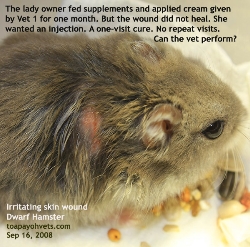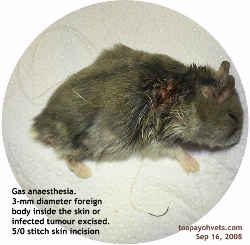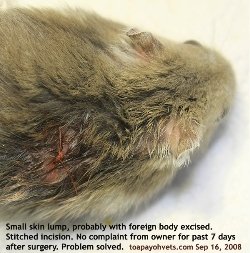|
|
|
SURGERY HOURS:
|
*10 a.m - 5 p.m (Mon - Sun,
except Sat). Dr Sing Kong Yuen. By Appointment Only.
*6 p.m - 10 p.m (Mon - Fri). 10am - 5pm (Sat). Dr
Jason Teo. House-calls available.
Appointment preferred.
Tel: 6254-3326, 9668-6469 |
EMERGENCY
11 p.m to 6 a.m
Dr Teo
Tel: 9853-1315,
9668-6469, 6254-3326 |
judy@toapayohvets.com
Fax: +65 6256 0501 |
|
|
|
Hamster Anaesthesia
and Surgery in 2001 |
Case recorded: Dec 18, 2001
Update: Sep 16, 2008
Dr Sing Kong Yuen, BVMS (Glasgow), MRCVS
The hamster has a swollen eye
 "My
hamster bites," warned Ms Tan as she put on two pairs of cotton socks to use
her hand to take her hamster out of the carrier. She had to restrain her pet
for examination of a swollen and half closed left eye. "My
hamster bites," warned Ms Tan as she put on two pairs of cotton socks to use
her hand to take her hamster out of the carrier. She had to restrain her pet
for examination of a swollen and half closed left eye.
The hamster moved all the time, up and down Ms Tan's hand, squeezing away
nimbly from her grip. As it wriggled towards her arm, she quickly pushed it
towards the protected hands area to avoid being bitten. She must have been
bitten a lot of times.
"It has a cut below its left eye," I said. "It had rubbed its sore and
you could see a swollen left eye area without any hair. It was trying
to relieve itself of the itch."
"How old is the hamster and how long had it been rubbing its left eye?" I
asked. The older the hamster, the more risky it will be to
anaesthesize it for treatment.
 Ms
Tan said "It is two years and nine months old and it just has this swollen
eye." Ms
Tan said "It is two years and nine months old and it just has this swollen
eye."
This was a sprightly ball of geriatric dynamite and in good bodily
condition. Most dwarf hamsters seldom live that long and Mr Tan could not
believe it was that old. A quick phone call to his wife confirmed the
age.
Definitely, it would be impossible to inject it with the anti-itch and
antibiotic injection as it does not stay still for a second.
We could wrap it round a towel but it would still wriggle out. Maybe
it would just die suddenly of fright and this would be traumatic for the
ten-year-old Ms Tan and her slightly older cousin Elsie.
I could put it under a gas anaesthesia so that it would stop moving and then
inject it. What if it dies of stress under anaesthesia?
Should I warn the young owner of the risk? She might start to cry.
Should I just leave it alone and gave some medication? Most owners
find it difficult to medicate a dwarf hamster. Based on its general
appearance of good health, the risks would be lesser. I recommended a
gas anaesthesia.
"How much it would cost?" asked Mr Tan. He had taken some time off to
bring the pet to a vet who was open at 5 p.m on this Hari Raya Puasa day and
had to rush to celebrate the breaking of the fast with his Muslim friends.
"Fifty dollars for the gas anesthesia, the consultation and treatment," I
said.
The two cousins said "wow". It was two times more than the cost of a
new dwarf hamster.
The general practitioner charged around fifteen to twenty dollars for a
consultation and medication of a common cold in human beings. I said
nothing. Mr Tan agreed to the fee.
The hamster was put into a small plastic container padded with cotton wool.
It was given a whiff of the anesthetic gas. "A strong smell," said Ms
Tan covering her nose as I put in the anaesthetic soaked cotton wool into
the box.
"Will it suffocate inside this box?" asked Ms Tan.
"No," I said. "I will take it out once it stops moving." I thought it
would be good to educate the pre-teens on how a hamster was anaesthesized
and reinforce their love and care for small animals by their active
participation in veterinary anaesthesia.
After ten seconds, I took out the half dazed hamster, put it on a table and
searched for its skin to inject it. The cousins were watching like a
hawk. Suddenly the hamster moved, extended its head and the two girls
screamed loudly.
A shrilling scream of worry in reaction or in anticipation of the hamster
biting or escaping?
My heart missed two beats. I pulled back my injection hand in a reflex
action. What were the girls screaming for? It is natural for
females of the homo sapiens to scream when they get surprised but then I did
not know human psychology, being an animal doctor.
The hamster was not fully knocked out to minimise the risk of death under
anaesthesia. But it should be just right for the antibiotic and
anti-inflammatory injection. It moved and it would bite soon and I
guessed the girls were worried. Or it was just their personality. This
scream could be distracting for a vet attending to a biting hamster.
"I guess you girls must go outside the operating room if I have to do my job
properly," I said as I banned them from watching and asked them to go into
the consultation room to wait. It was more traumatic to them. I put
the hamster back into the container to give it another whiff of the
anaesthetic gas.
As the hamster just closed its eyes, I took it out and injected it. Then I
put him back into the plastic container to prevent him escaping and falling
off the surgery table. "No more dusty wood litter or pellet food for the
next ten days," I said as I put an eye drop onto this hamster's left eye and
put tissue paper into its container. The hamster was already moving
just after the injection.
The cousins changed the tissue paper as the hamster had just passed water.
"It would be best to leave it alone just after anaesthesia," I said. "It may
just die of heart failure."
 The
hamster soon recovered as if it had a short nap. The cousins went home
happily. They knew that the dwarf hamster may have only three months
of its life span left as dwarf hamsters seldom live more than three years.
Nobody knew what caused this facial cheek wound as the hamster was living
alone. There were no sharp wires inside its cage. The
hamster soon recovered as if it had a short nap. The cousins went home
happily. They knew that the dwarf hamster may have only three months
of its life span left as dwarf hamsters seldom live more than three years.
Nobody knew what caused this facial cheek wound as the hamster was living
alone. There were no sharp wires inside its cage.
What will happen if this hamster was not given an antibiotic and anti-itch
injection? Most likely, it would rub and rub its left eye till the
whole area loses more hair. Then the ulcerated skin would get infected
badly. It would then lose appetite as it developed bacteraemia, an
infection of the blood by bacteria.
By then, it will be too late to do any treatment as it will be too sick to
survive. The vet will then be blamed for killing the hamster
after the injection.
I wonder how such affected hamsters will survive in the wild? Most
likely they will not survive such itchy wounds. They would rub the wound
till it became sore and festering. Bacterial infections on the wound would
finish off the hamster. |
|
Hamster Anaesthesia
and Surgery
& Photography in 2008 |
Case recorded: Sep 16, 2008
Dr Sing Kong Yuen, BVMS (Glasgow), MRCVS
A one-visit cure for the hamster with an irritating wound.
Can the Vet Give What the Customer Wants?
Times are really bad for many self-employed people in the trade that
has not much demand. Another famous Lehman Bank had collapsed while
the Singapore Government keeps increasing prices of consumer goods
and erected more ERPs (Electronic Road Pricing toll gates).
Now, there is even one ERP at the only entrance to my Surgery from
Braddell Road. My surgery is in the heart lands.
Bad luck to me and all the Toa Payoh residents as they now can't
escape paying tolls if they drive into the only road to Toa Payoh
from north of Singapore. The Singapore bureaucrats could have
erected the ERP at the exit point from Toa Payoh town. But they do
it at the only entrance road to Toa Payoh town. Why should they care
about increasing the cost of living?
 For
this self employed hamster owner, I empathised with her and
understood that she had to cut down the expenses. Her trade was not
one which had many customers. She was passionate about her business
and sometimes passion does not translate to dollars and cents so
fast. For
this self employed hamster owner, I empathised with her and
understood that she had to cut down the expenses. Her trade was not
one which had many customers. She was passionate about her business
and sometimes passion does not translate to dollars and cents so
fast.
She wanted her hamster
cured in one visit at the least cost and had phoned for an estimate
of an injection. She had used past medication from Vet 1 who
is reputed to be the most expensive vet in Singapore. But she had
not cured the hamster.
"I wish to have the injection
to bring down the itchiness," the lady owner said. "Will this cure
the hamster if there is no itch and therefore he will not scratch
the wound."
I said, "I can't guarantee this. Sometimes it works. If it does not
work, you will have to come back again. I can feel a small lump
under the skin. Around 3 mm in diameter. It could be an inflamed
foreign body. A small object penetrated into the skin and causing
irritation for the past one month.
 I
continued, "Therefore, it is better that the irritating lump by
excised. Did you feel it?" I
continued, "Therefore, it is better that the irritating lump by
excised. Did you feel it?"
The lady owner nodded her head. Now, surgery and anaesthesia would
be more costly than an anti-inflammatory injection. She has to
decide whether the $50.00 injection would work or pay double. Or
return for another treatment and pay again? She needs to PAP (Pay
and Pay)?
It was hard for her to decide. A one-visit cure was what she wanted.
If only the vitamin supplements and other medication from the most
expensive veterinarian in the country for a previous hamster problem
had worked.
"Why don't you just give the injection?" the lady said.
"OK," I replied. "If the injection does not cure the hamster, you
will need surgery." I did not want misunderstanding later and
therefore repeated my comments a few times.
These remarks caused a hesitation and a dilemma. A repeat visit
costs money and time. What should the lady do now?
 "It
is best that the lump be excised out," I advised as this procedure
would most likely cure the hamster and reduced her veterinary costs
of repeat visits and frustrations considerably. "It
is best that the lump be excised out," I advised as this procedure
would most likely cure the hamster and reduced her veterinary costs
of repeat visits and frustrations considerably.
The lady bargained hard. The hamster probably had a penetrated
foreign body under the skin. Removal of this small 3-mm piece of
skin and subcutaneous tissue and stitching up cured this hamster. No
complaints for the past 7 days. I presumed the hamster was now OK as
the owner was asked to phone me if there was problems.
Sometimes the advice to
perform surgical
excision is needed to remove infected skin and irritating skin
wounds. All pet owners want a one-visit cure to save on
veterinary cost.
If the vet cannot
perform, he just will not get repeat business! No repeat business
can lead to veterinary bankruptcy sometimes. |
|
 TOA
PAYOH VETS
TOA
PAYOH VETS TOA
PAYOH VETS
TOA
PAYOH VETS